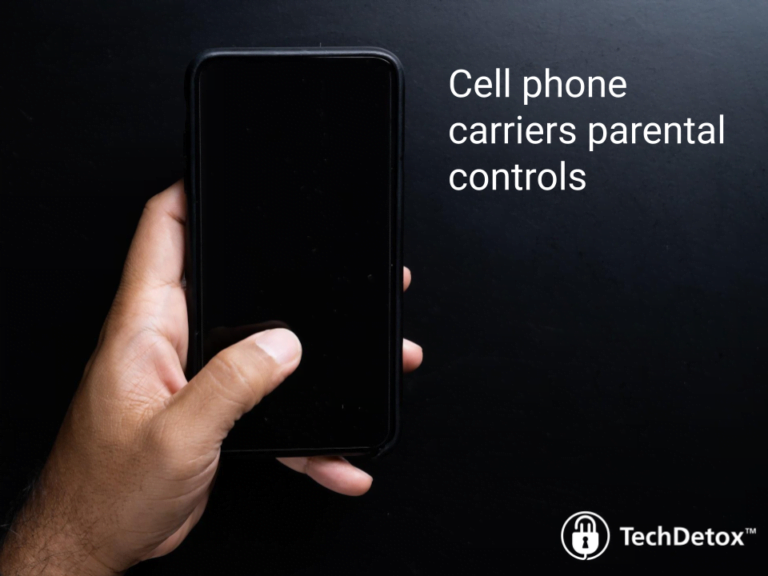
Cell phone carriers parental controls: should you buy them?
Are they worth it?
Given the multitude of parental controls and screen time management options available – built-in settings like Apple’s ScreenTime and Google’s FamilyLink, as well as a number of third-party screen time management apps, why do we even need to look into the cell phone carriers’ options? Isn’t this redundant?
Yes and no.
If your teen is only browsing the Internet on a family WiFi network, no problem. You can put content filters on it to protect them.
But when they are using their cell phone DATA – which is the case most of the time when they are not at home – your family WiFi network filters do not apply.
If data on the cell phone is unrestricted and no other parental controls are enabled, they can access unrestricted content.
For an unrestricted amount of time.
In fact, this is one of the easiest hacks kids use to circumvent parental controls parents installed on a family WiFi network.
A combination of several layers of parental controls solutions can take care of problems parents are concerned about – from excessive screen time to questionable content. Cell phone service providers can be one of those layers. Useful? Yes. Absolutely necessary? Probably no. Comprehensive? Far from it. It is usually a paid subscription service and can be pricey compared to other solutions. Cell phone service providers’ main product is to provide screen time, not to restrict it.
What cell phone company can do better than any other screen time app is monitor their own traffic: phone calls, text messages, and the amount of data going through a particular phone number.
If it goes through their pipes, they can see it.
Even when you do not subscribe to carriers’ parental controls offerings, they are already using sophisticated systems to protect their users – because when users receive spam or inappropriate messages, they might get mad and stop being a customer. Unfortunately, this usually applies to simple phone calls and texts, which is only a fraction on the problem.
Even though screen time management is not their core competency, cell phone service companies do offer parental controls. If you are a customer of their cell phone plans, look into it, otherwise built-in or third-party screen time solutions might be sufficient.
T-Mobile
T-Mobile FamilyMode aims to be a broad screen time management solution. T-Mobile FamilyMode app combined with T-Mobile FamilyMode Home Base that plugs into your WiFi router gives you control across multiple devices, connected both via data and WiFi.
The system is designed for the same purposes as other screen time management solutions: limit time and limit content. Many other players on the market do the same thing: device usage can be monitored and limited by third-party apps just as well.
A less comprehensive feature specific to T-Mobile is Family Allowances that let you monitor talk and text usage:
What parents can do:
- The Parent Line and the Primary Account Holder (2 parents) are both authorized to manage allowances for kids (managed lines).
- Parents can monitor and set a talk time limit, except for Always Allowed numbers which can be reached anytime.
- Parents can monitor and limit the number of text messages a line can receive and send.
- Parents can monitor and limit the amount spent on downloads (games, apps) per account line.
- Parents can allow or block when children (managed lines) can use their devices, such as during school (9 a.m.-2 p.m.), during homework or dinner time (4-9 p.m.), or when they should be sleeping (9-11 p.m. and 11 p.m.-6 a.m.).
- Prevent kids from finding workarounds
- Turn off data to kids’ phones
- Family Allowance settings don’t work on Wi-Fi
AT&T
AT&T has followed the example of T-Mobile and developed a screen time management app of their own, AT&T Secure Family, that works on several cell phone platforms, including AT&T, Verizon, T-Mobile, and Sprint. It replaced its predecessor app, the Smart Limits. It’s a paid monthly subscription service.
What parents can do:
- Track location of family members
- Filter inappropriate content on most Android smartphones and iPhones for up to 10 phone lines
- Block app purchases
- Set time limits
- Pause access to the Internet
What parents cannot do:
- Like any app it has limitations in monitoring the content of individual messages and messaging apps.
- Can be hacked by motivated teens – so if you use it, make sure to supplement with other parental controls solutions.
Verizon
Verizon’s parental controls system is a subscription service called SmartFamily, which can be managed on Verizon’s website or through the Verizon Smart Family app paired up with a companion app on a child’s phone.
What parents can do:
- Block contacts and numbers, set trusted contacts
- Pause child’s internet
- Track their location
- Filter content, block websites
- Set time restrictions when you don’t want your child to be able to call, text or use data or Wi-Fi
- Limit data usage
- Limit purchases from the Verizon account
- Limit texting
- Set call restrictions by limiting the number of minutes
- View child’s call and text activity
- View child’s web and app activity
What parents cannot do:
- Unfortunately, the only way to read the actual messages, see pictures and videos, or see the content of messaging apps – what parents really would like to do anonymously – is on child’s phone. Third-party messages (the ones kids actually use) won’t show up on the activity log either.
- Any activity that is offline (such as offline gaming) will not be visible
- An app cannot be blocked manually, but an app store can be restricted to prevent downloads
Sprint
Sprint’s parental controls are managed online from your Sprint account or from a Sprint app under Permissions. Parental Controls is a free service to Sprint customers, so the decision is easy – use it.
What parents can do:
- Restrict Internet access to age-appropriate content while browsing on the Sprint network
- Restrict unwanted calls and text messages from blocked telephone numbers
- Block digital media downloads
- Restrict voice calls to pre-approved list
- Restrict camera use
What parents cannot do:
- See the content of individual messages, other than on kids’ phone itself
- The content filter only works when web pages are accessed through the Sprint network.
Note: Sprint and T-Mobile had merged into one company, so it is likely that an integrated T-Mobile parental controls will be used on Sprint network going forward.
Take Back Control
Sign up for our monthly newsletter to receive latest digital wellbeing research and screen time management solutions. We never share your email with third parties.So What?
Bottom line: if you choose to subscribe to your cell phone carrier parental controls service, do not forget to supplement it with other screen time management solutions – particularly the ones that do a better job than cell phone companies of monitoring the content kids receive and send on their phones.
When it comes to connectivity, kids can go around WiFi restrictions using data, and can go around data restrictions using WiFi.
So it’s important to monitor both. There is an ever-expanding universe of ways kids discover to bypass parental controls, including those of cell phone carriers. That’s why it’s a good idea to install several layers of parental controls, starting from good parenting and digital media family rules, to screen time management apps and solutions, to physically taking the devices away.

